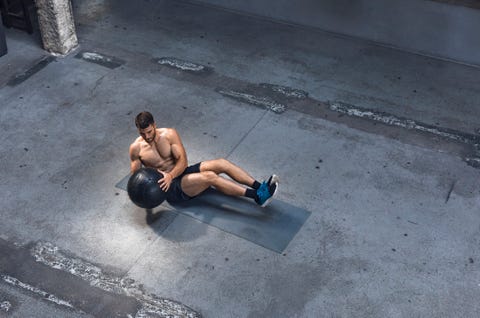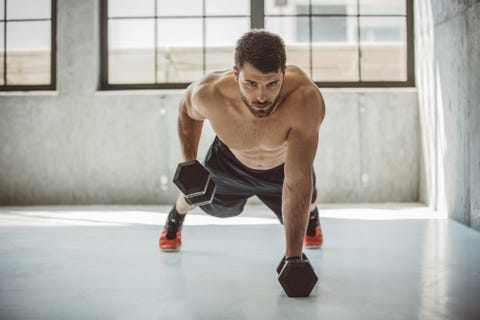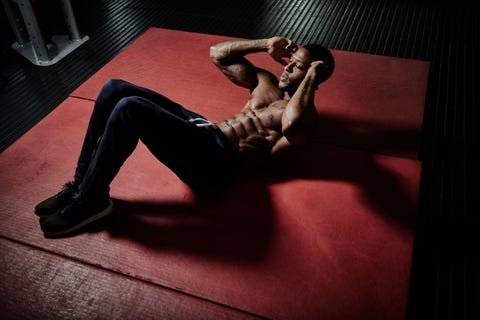The following is an excerpt from the new Men’s Health training guide 90-Day Transformation Challenge: Abs. In one volume, you’ll get all the tools you need—information, a nutrition guide, and workouts—to build your abs in just 3 months.
Planning your program, as I have said repeatedly, should be a collaboration among all the elements that will make you look and feel better. Understanding the muscles and what they specifically do gives you the first layer of knowledge needed to better prepare your training regimen.
To take the next step, you have to look at the four categories of movement (and anti- movement) that you will master as this plan progresses. These four types of movement are essential to building your abs. You can’t rely on just one motion, like the forward folding of crunches, to get the results you want.
All four of these categories won’t just enhance the skills you already have but will add some completely new tools to your tool belt. This won’t just make your abs look better— you’ll run faster, hit new PRs, and exceed your existing limits! Here’s a look at the four categories and their functions.
Bracing
Bracing is one of the most undervalued skills in training. You have to brace what you want to protect, and in this case, it refers to your spine position. The posture you carry around on a daily basis is the same posture you are bringing into your lifts. Whether you have a barbell on your upper back for a squat or a trap bar in your hands for a deadlift, if you don’t brace properly, you are at risk for injury.
Bracing is the act of creating stability between the shoulders and hips. It should feel like strong lines of tension connecting the bottom of your chest with your hips. One of the most common misconceptions about bracing is that you can engage it by sucking in your stomach. What that does is remove the intra-abdominal pressure from your midsection, which is the exact opposite of what we want to accomplish.
Intra-abdominal pressure is defined as steady state pressure in the abdominal cavity. This mechanism is there to better stabilize your midsection. Imagine that your upper body is an empty plastic water bottle. If there is no cap on the water bottle (no pressure, no bracing), it takes almost no effort to bend the bottle whichever direction you would like. But if you put the cap on top (air pressure, bracing), it is almost impossible to bend the water bottle. This is the same type of mechanism we are trying to use in our training.
As I said earlier, the core is an energy transfer junction. If you are sprinting, squatting, pressing, whatever, you need to know how to properly brace your core and to what extent.
Rotation
Rotation is an essential movement. Most of the moves you see people doing in the gym work in isolated motions, through straight lines, and that’s not very comparable to the way we live our everyday lives. The fact is, we rotate (a lot). Think about turning your body to see when you’re merging onto the highway or twisting your torso to put the groceries away.
Rotation is the integration of multiple joint and muscular systems working around a center point. More often than not, that center point lies in the midsection, especially if we are doing movements around our body or from varying levels. While we don’t want to generate our power in rotation from the midsection, you have to respect the fact that we need to maintain a level of ease in movement through this area to remain safe. More important than rotation in this area is….
Anti-Rotation
As I said, rotation is an essential movement. When we move, the body is only willing to go to lengths where it feels safe. Building the framework for the body to feel safe and comfortable through movement unlocks new opportunities in movement.
Just like you wouldn’t want to learn how to ride a bike without brakes, you don’t want to learn how to properly resist rotation at the midsection before you know how to rotate.
The skill of anti-rotation is similar to bracing; it is acquired through practice. One of the key reasons this plan is so successful is that it unfolds over the course of 90 days, giving you time to slowly build one skill on top of another. This will be one of the recur- ring themes in our program.
Spinal Flexion
Bending forward is a common everyday movement. Although it’s often neglected lately, spinal flexion prepares us for common movements, so we need to get better at performing this essential move. To better prepare for this everyday movement, we need to refine our approach to it.
And yes, this means that movements like situps aren’t all bad. In the fitness world, some moves go out of style and in recent years, spinal flexion has been demonized as “a problem.” But flexing your spine, as you do during situps, is something you do every morning when you sit up and get out of bed—and when you pick up something from the floor too. Bending forward won’t harm you. Poor execution of exercises will! This is why I want to emphasize your form and technique every step of the way.
This content is created and maintained by a third party, and imported onto this page to help users provide their email addresses. You may be able to find more information about this and similar content at piano.io







Comments are closed.